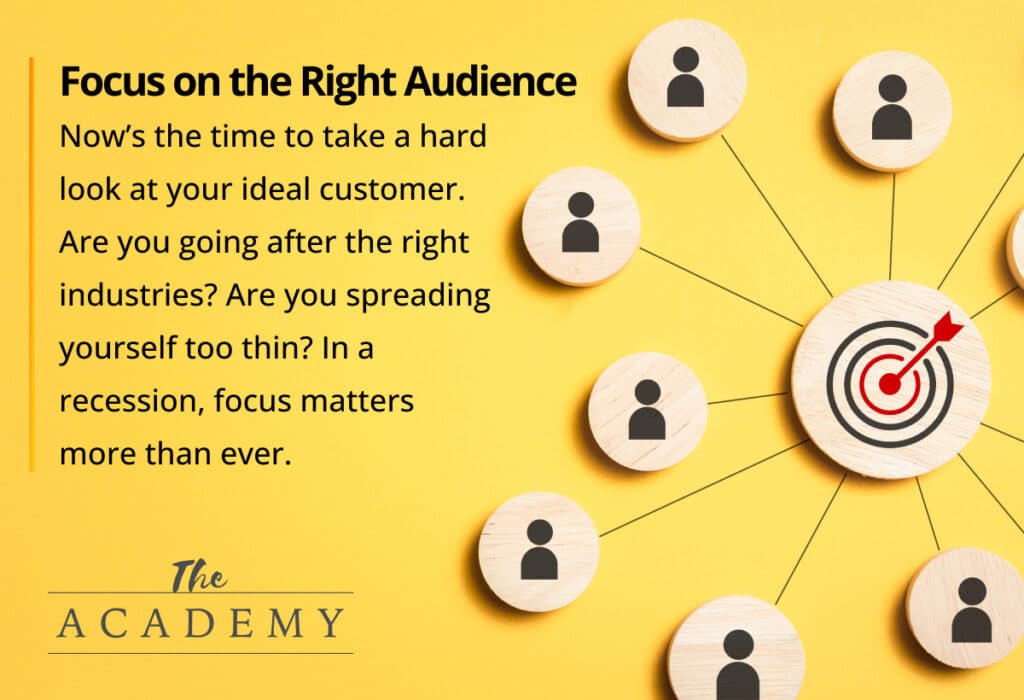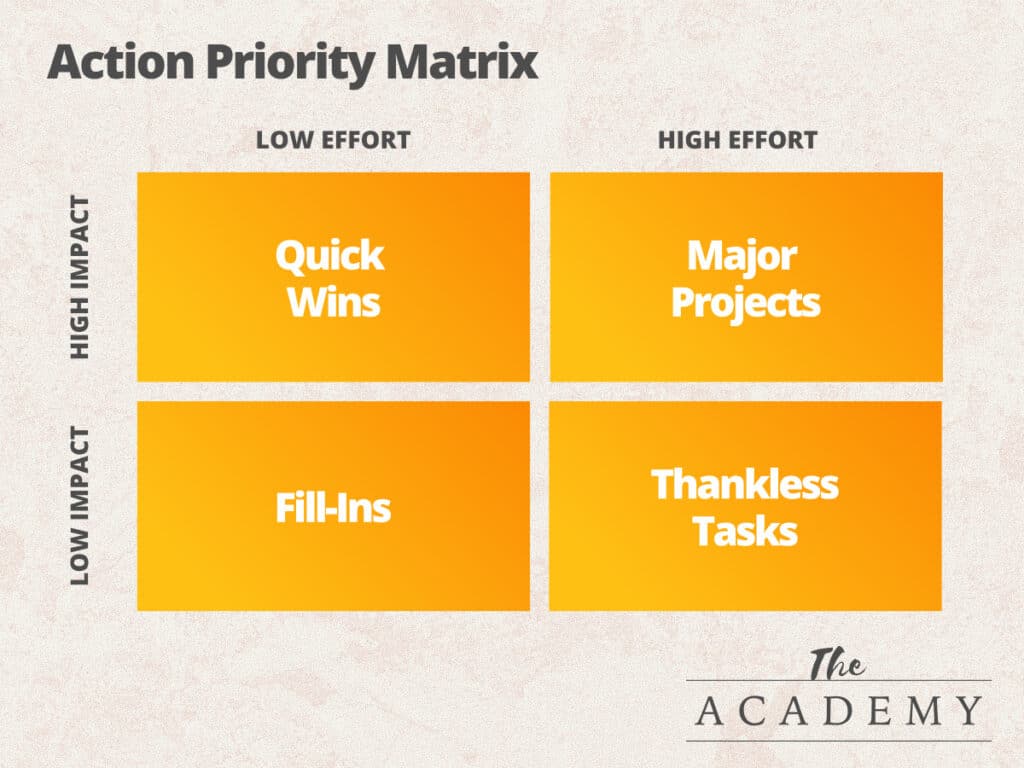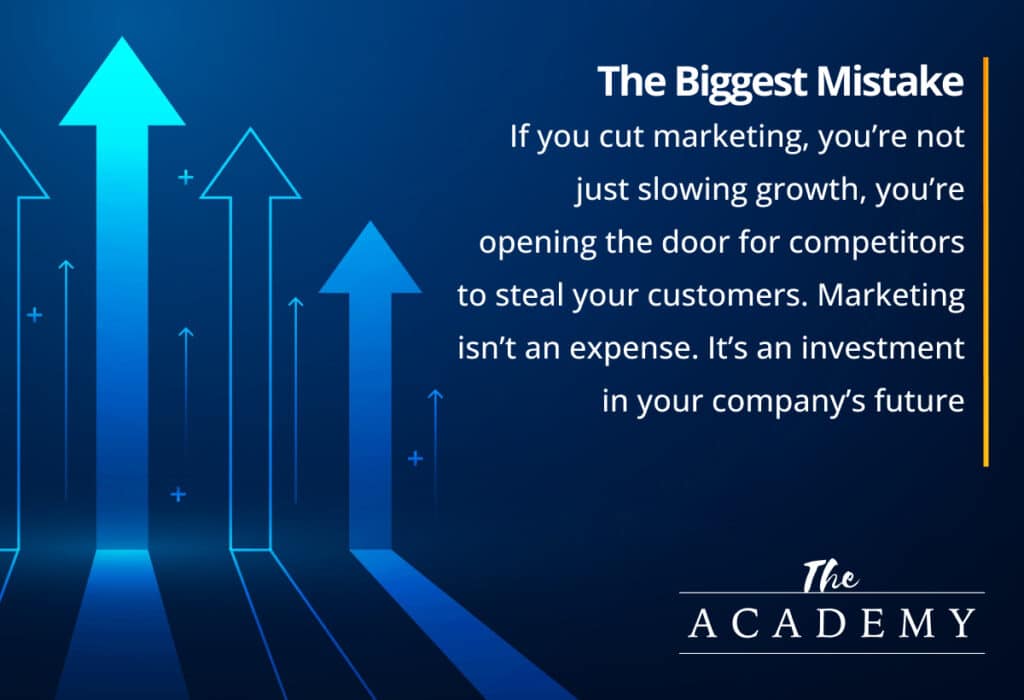
When the economy gets shaky, businesses start looking for ways to cut costs. And all too often, marketing is the first thing on the chopping block. It’s an easy target, right? But here’s the problem: history shows that pulling back on marketing during a downturn actually makes things worse.
One classic example found that companies that cut their advertising budgets saw a 7% drop in sales, while those that stayed the course—or even increased their spend—saw a 20% boost. So instead of hitting the brakes, smart businesses shift gears. They invest strategically and set themselves up for serious growth once the economy bounces back.
Right now, with ongoing concerns about tariffs, inflation, and economic slowdowns, it’s time to think strategically, not reactively. If you’re considering cutting marketing, don’t. Instead, here’s how to make it work smarter, not harder.
Step 1: Focus on the Right Audience
Are You Talking to the Right People?

Now’s the time to take a hard look at your ideal customer. Are you going after the right industries? Are you spreading yourself too thin? In a recession, focus matters more than ever.
Consider doubling down on recession-resilient industries, like:
- Healthcare & Pharmaceuticals – People still get sick, and hospitals still need supplies.
- Food & Beverage Manufacturing – Everyone’s gotta eat.
- Logistics & Supply Chain – Efficiency matters even more in tough times.
- Essential B2B Services – Compliance, security, and IT aren’t optional.
We’re not recommending a complete shift in your strategy, but if you have a client mix that includes recession-proof industries, consider them as foundations to build upon.
Are You Focused on the Right Goal?
Here’s the big question: Do you need more leads, or do you need better conversions?
- If you need more leads, focus on brand visibility, SEO, and paid ads.
- If you need to close more deals, double down on sales enablement, retargeting, and nurturing warm leads.
Don’t Forget About Your Existing Customers
New business is great, but don’t ignore the low-hanging fruit—your current customers.
- Are you sure they know about all your services?
- Are you doing enough to protect them from competitors trying to steal them away?
- Can you upsell or cross-sell to get a bigger share of their budget?
The easiest, most cost-effective sale? One to someone who’s already working with you.
Step 2: Prioritize High Leverage Efforts
Use the Impact vs. Effort Matrix

In this example, ‘Effort’ can be interchanged with ‘Cost’
Marketing dollars are precious. Instead of throwing money at everything, use an Impact vs. Effort Matrix to rank your options:
- High Impact, Low Effort (Sweet Spot) – Quick wins that move the needle.
- High Impact, High Effort (Worth It, but Plan for It) – Big moves that take time.
- Low Impact, Low Effort (Nice to Have, Not Essential) – Do if you have bandwidth.
- Low Impact, High Effort (Avoid) – Don’t waste your time.
So where should you focus your efforts? Here’s what works best in a downturn:
1. SEO & Content Marketing: Play the Long Game
Even in a recession, people keep searching for solutions. If you’re not showing up, your competitors are. SEO and content marketing:
- Bring in leads without ongoing ad spend
- Build trust when buyers are hesitant
- Position you as the go-to expert
2. Paid Ads: But Be Smart About It
A lot of businesses pull back on ads in a downturn, which makes it cheaper for those who stay in the game. If you run paid ads, focus on:
- Bottom-of-funnel keywords (buyers ready to act)
- Retargeting warm leads (keep your brand in front of them)
- Competitive advantage (fewer advertisers mean lower costs!)
3. Email & CRM Marketing: Work Your List
Your email list is gold. Use it to stay top-of-mind and nurture leads without spending a dime:
- Send valuable insights (not just sales pitches)
- Segment your list to make emails more relevant
- Automate follow-ups to support your sales team
4. Sales Enablement: Help Close the Deal
Your marketing team’s job isn’t just to attract leads—it’s to help sales close them.
- Create case studies showing clear ROI
- Develop interactive tools (like savings calculators)
- Offer flexible pricing options to ease buyer hesitation
Step 3: Test & Invest
If You Can’t Measure It, You Can’t Manage It
Now is NOT the time for “hope marketing.” You need data-driven decision-making.
- Set clear KPIs (leads, conversions, cost per acquisition).
- Track marketing ROI to double down on what’s working.
- Use the Plan-Do-Check-Act method:
- Plan your strategy
- Do implement campaigns
- Check results
- Act based on insights to refine and scale
Be Disciplined: Test, Scale, Repeat
Instead of betting big on untested ideas, start small.
- Cut what doesn’t work
- Expand what does
- Balance short-term wins with long-term growth
The Biggest Mistake? Thinking Marketing is a Cost, Not an Investment
Here’s the harsh truth: If you cut marketing, you’re not just slowing growth, you’re opening the door for competitors to steal your customers.

- Marketing isn’t an expense. It’s an investment in your company’s future.
- The businesses that stay visible during a downturn recover faster and stronger.
- Your competitors are watching. If you pull back, they’ll fill the gap.
Final Thoughts: Play the Long Game
Recessions make people nervous. But they also create opportunities. Companies that continue investing don’t just survive—they come out ahead.
So ask yourself: Are you cutting costs or investing in growth?
The businesses that keep marketing through downturns? They’re the ones that win big when the economy turns around.
Want to Read More? Additional Resources:
For further reading, check out these expert perspectives on marketing through a recession:
- How to Market in a Downturn – Harvard Business Review
- Surviving A Recession With A Strong Marketing Strategy – Forbes
- Marketing in a Recession: Your 8-Step Action Plan – Fratzke Media
- The Dos and Don’ts of Marketing During a Recession – Invoca
- Marketing during a recession: Strategies for businesses – Stripe
Most Popular Articles

Seeing Favicons in Your Google Search Results? Here’s Why…
Have you noticed anything different in your Google Search results lately? Google added tiny favicon icons to its organic search results in January. It was…

Business Growth and Digital Marketing News & Tips 11-17-24
Are you encouraging and rewarding innovation? Lee Cockerell is the former Executive Vice President of Operations at Walt Disney World. A lover of traditional red…

Business Growth and Digital Marketing News & Tips 11-27-24
A culture of gratitude "Feeling gratitude and not expressing it is like wrapping a present and not giving it." – William Arthur Ward Beyond being…








